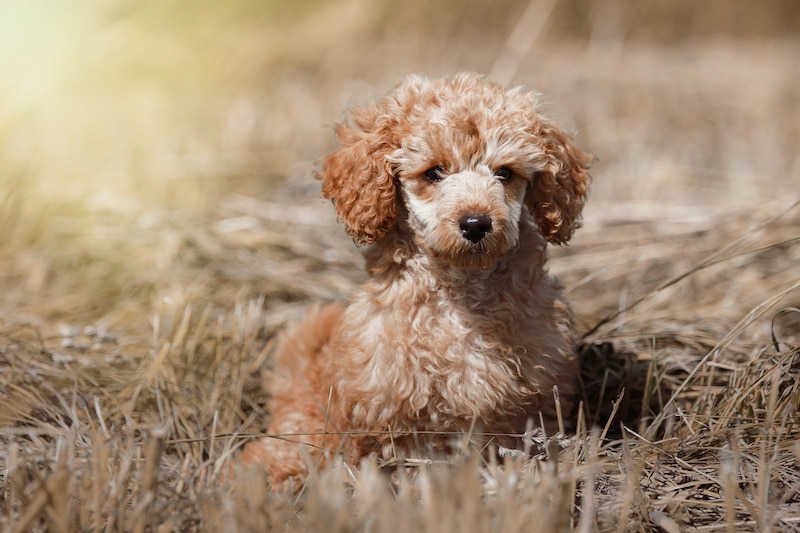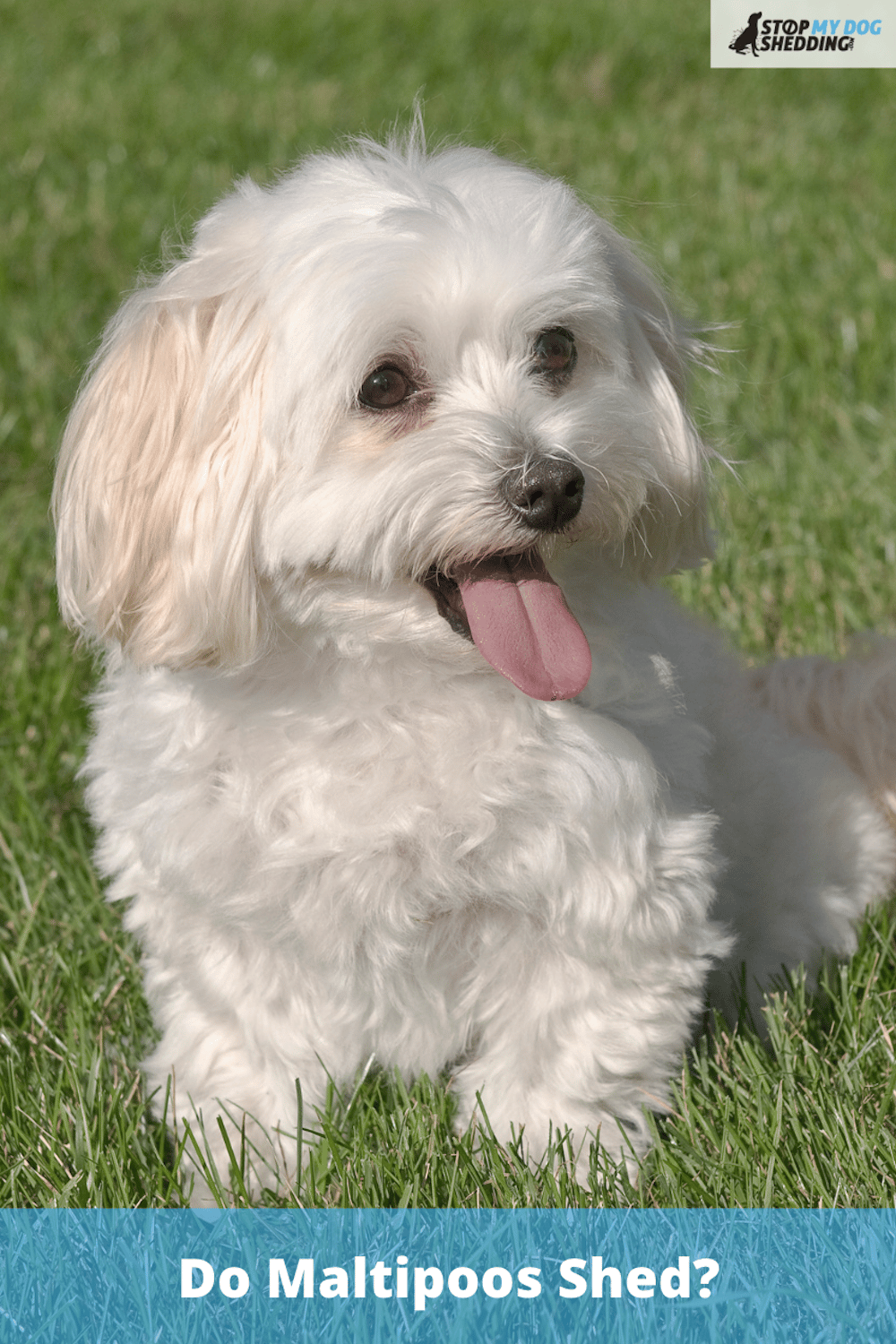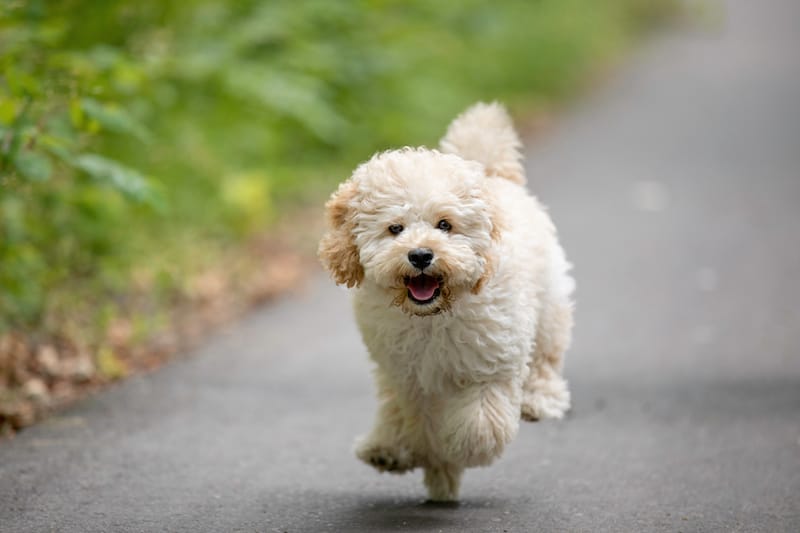The Maltipoo is a tiny designer dog breed that’s a cross between a Miniature Poodle and a Maltese. Beloved for its handheld status and undeniably adorable looks, you might have your eye on a Maltipoo.
But do they shed much?
Maltipoos, given their lineage, are incredibly low-shedding. However, the dog’s often curly coat is difficult to groom. You also have to be on the lookout for tear stains quite regularly.
In this guide, I’ll fill you in on all things Maltipoo shedding, so you know what to expect from your dog. I’ll also discuss the dog’s grooming requirements and other elements of its care.
So if you’re looking to adopt, read on!
Maltipoo Shedding
Maltipoos, as I touched on in the intro, are bred from the Maltese and Miniature Poodle.
To understand more about just how little a Maltipoo sheds, I thought it would be enlightening to examine the shedding habits of both parent breeds.
Let’s start with the Miniature Poodle, which is about 15 inches and 12 to 20 pounds. Maybe it’s not mini by a lot of people’s standards, but it’s certainly smaller than the standard-sized Poodle. And either way, Mini Poodles shed very little hair.

Why? Well, for one thing, there’s the dog’s size. A Mini Poodle just doesn’t have very much surface area to it, especially compared to the bigger Standard Poodle.
The dog is also single-coated, and its coat type plays a major role in its shedding propensity.
As you may know, the Poodle is covered from head to toe in tightly-wound curls. And those curls trap dead hair as it sheds, so it doesn’t end up all over the floor or your new couch.
Poodles also have a relatively slow hair growth cycle, which means that it takes longer for the hair to reach the stage where it’s shed and replaced by new hair.
What about the Maltese, the other parent of the Maltipoo and a big contributor to its adorable looks? Well, when it comes to low-shedding dogs, you really needn’t look much further than the Maltese. Shedding-wise, it’s pretty much in the same boat as a Poodle and Bichon Frise.

Many of the same reasons the Maltese sheds so little are reasons for the Poodle’s low-shedding nature as well. For example, the Maltese is single-coated, and it has long hair. In fact, its hair is far longer than a Poodle’s coat!
The dog is also smaller than even a Mini Poodle, as the Maltese’s average size is nine inches and 8.8 pounds. So when you put that all together, you can see how the Maltipoo is incredibly low-shedding as well.
Unlike numerous other designer dogs (like the Aussiedoodle, Goldendoodle, or Sheepadoodle), you don’t have to worry about the Maltipoo’s exact genetics to figure out how much it’s likely to shed, as both parents are extremely low shedders.
That said, the type of coat the dog has is important for other reasons, such as looks and grooming, which I’m about to jump into now.
Grooming Your Maltipoo
Grooming the Maltipoo will not be a cakewalk.
The Maltipoo is commonly very curly, which is a trait it gets from the Miniature Poodle.
As beneficial as Poodle coats are in the shedding department – when it comes to brushing, you’re in for a challenge. You’ll need a slicker brush and the right combing technique.
The key is not to press too hard with the brush and never to brush too deeply. You’ll pull at the curls and hurt your Maltipoo.
You can also use a bristle brush for your Maltipoo, especially if the dog has finer curls or straighter hair like a Maltese does.
The bristle brush is quite handy for removing any debris that can get stuck in the fur and possibly lead to painful knots or tangles.
Brushing needn’t be a daily occurrence unless you want to keep the coat utterly pristine. At the very least, you should plan to brush your Maltipoo a few times per week.
When you brush your Maltipoo, you’re collecting its loose fur that’s been trapped in those curls and disposing it of so it can’t shed all over the house.
You’re also spreading skin oils that will moisturize the skin and make the coat glossy and shiny. Moisturized skin doesn’t itch, so your Maltipoo won’t scratch itself bald in some places.
Poodle coats normally get rather poofy, too, especially if it’s been a while since the dog has been trimmed. That’s why it’s a good idea to pick up the dog grooming scissors at least once a month. You can go as long as six weeks, but any longer than that, and your pup might begin to look unkempt.
I recommend picking a cut out of the Maltese cut playbook rather than the Poodle cut playbook.
One of the easiest cuts is the short cut, which entails trimming your Maltipoo’s coat to a manageable length throughout.
The teddy bear cut, although a bit more advanced, is also a very cute look on the Maltipoo. You’d trim the head to have a fluffy and round shape and then cut the fur on the rest of the body, so it’s closely cropped.
Of course, if these cuts sound too complex or time-consuming for you, feel free to take your Maltipoo to a groomer.
Besides brushing and trimming, you also have to bathe your Maltipoo. You can do this as frequently as monthly but use your discretion. Bathing too much can lead to dry, itchy, irritated skin.
Unless your dog is visibly dirty and/or smelly, you can probably wait longer than 30 days to bathe the Maltipoo.
When it is time for a bath, use dog-friendly shampoo (and conditioner, if you please) and lukewarm water.
Resist the urge to towel-dry your dog, which can tangle the Maltipoo’s coat. Use a hairdryer on a low heat setting instead. Or, ideally, a dog hair blow dryer.
It’s also a good idea to regularly wipe the Maltipoo’s eyes with a damp cloth or tear stain remover, as tear stains are something the Maltipoo gets from the Maltese, and these dark marks can look very striking on an all-white dog.
Recommended: Go here to see our top-rated dog hair blow dryers
About the Maltipoo (Should You Adopt?)
The Maltipoo is a crossbreed designer dog that’s part Maltese, part Miniature Poodle. And like many designer dogs, they were bred to be an adorable companion.
This dog loves having fun, is ultra-adaptable, very friendly, and oh so affectionate. Maltipoos are considered quite smart and easily trainable, and they have a low prey drive to boot.
Is a Maltipoo a good apartment dog? A full-grown Maltipoo is eight to 14 inches and weighs no more than 20 pounds. So she shouldn’t take up too much room in even a cramped apartment.
Maltipoos are also moderately energetic but not overly so. Taking your pup to play at a local dog park each day should tire them out.
Of course, if you have even more space in your home, that’s great too! The Maltipoo will happily play with you in your yard and spend time learning tricks and commands here as well.
Recalling that Maltipoos are adaptable, this small hybrid breed should be friendly with other canines in the house, especially with socialization. That said, you might not want to mix a very large breed with a Maltipoo, or the poor dog could be bowled over.
The Maltipoo can also have a harmonious relationship with household cats if the dog is introduced to the feline early and proper socialization occurs.
The gentle, loving nature of the Maltipoo means this pup gets along well with kids of all ages.
You might want to rethink introducing very young kids to the Maltipoo, though. This small, fragile dog could be hurt by rambunctious kids at playtime.
And if you like a quiet house, rejoice. The Maltipoo is known for barking infrequently and not being a loud barker, either.
Bottom Line
The Maltipoo is a half-Toy Poodle, half-Maltese designer dog. Sweet, adorable, and very low-shedding, there’s a lot to love about this dog.
While grooming the Maltipoo is time-consuming and requires attention to several areas, the companionship this dog can provide makes all the hard work worth it!













Please note: By submitting a comment using the above comment form, you confirm that you agree with the storage and handling of your data by this site as detailed in our Privacy Policy.